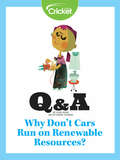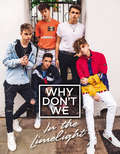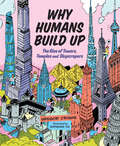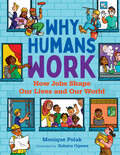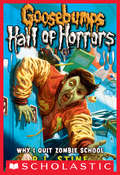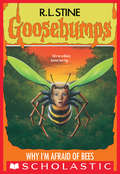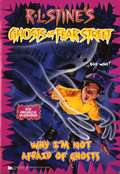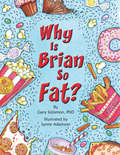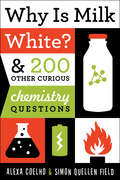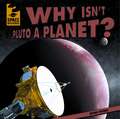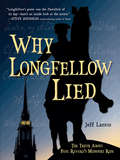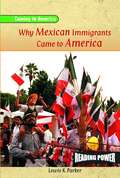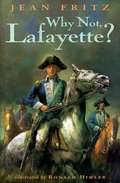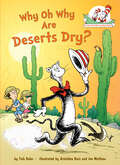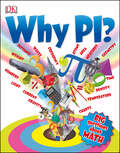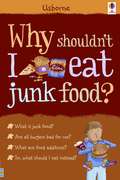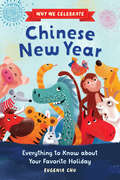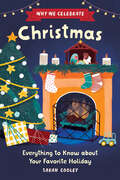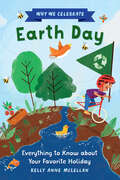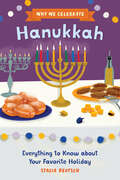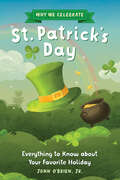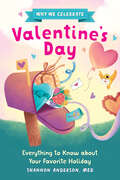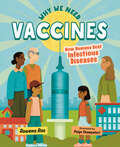- Table View
- List View
Why Don't Cars Run on Renewable Resources?
by Lizzie WadeA bioengineer at Tel Aviv University in Israel explains how to extract renewable energy from a potato.
Why Don't We: In the Limelight
by Why Don'T WeIn the Limelight is the official Why Don’t We autobiography, full of never-before-seen photos and behind-the-scenes info about one of today’s hottest bands.When five guys decided to form a band, they never imagined that they would go from playing music online to playing tours across the world so quickly. Why Don’t We has been together for less than two years, and they’ve already headlined sold out shows, played at Madison Square Garden, and amassed millions of fans. And this is all just the beginning.This is the official Why Don’t We story, full of never-before-seen photos and everything you need to know about Corbyn, Daniel, Zach, Jonah, and Jack. Find out the secrets they’ve never shared with fans before, their embarrassing childhood stories, what they look for in a girlfriend, and how it felt to have their lives completely changed by this incredible journey.
Why Don't You Get a Horse, Sam Adams?
by Jean FritzIn the early days of America when men wore ruffles, rode horseback, and obeyed the King, there lived a man in Boston who cared for none of these things. No one expected Samuel Adams to wear ruffles or pledge allegiance to the King of England, but his friends did think that he might get on a horse. But would he? Never! he said. An ALA Notable Children's Book.
Why Humans Build Up: The Rise of Towers, Temples and Skyscrapers (Orca Timeline #1)
by Gregor Craigie★“This great STEAM offering has multiple applications and will be useful for report writers and aspiring architects alike.”—Booklist, starred review ★“Finely detailed inside and outside...Broad in scope, perceptively organized, and enriched with fascinating entries.”—Kirkus Reviews, starred review Why did they build it so high? People have been constructing tall buildings for thousands of years, for many different reasons. Castle walls kept people safe. Utility towers transmit TV and cell-phone signals. Observatories give people a bird’s-eye view of the world. Beautiful buildings stand out in the crowd. Skyscrapers provide housing for a lot of people. There are some good reasons for building up, and a few bad ones as well. With a growing global population, we will need more and more space to live, learn and work in. But what does that mean for the health of the planet? Can we do it sustainably? Tall buildings may be part of the answer. From the Great Pyramids of Giza and the Leaning Tower of Pisa to the Burj Khalifa and the Shanghai Tower, Why Humans Build Up asks why and how we build higher and higher, and what that means for the planet.
Why Humans Work: How Jobs Shape Our Lives and Our World (Orca Think #6)
by Monique PolakWhat do you want to be when you grow up? I bet you've been asked that question before. But have you ever thought about why humans work? There are almost 3.5 billion people working in the world today, and that number is growing. In Why Do We Work? author Monique Polak investigates the past, present and future of jobs, including how work has also been shaped by discrimination, privilege and child labor. Meet a variety of working professionals and explore why we have careers, vocations and professions. How is the way we work changing, and what will it look like in the future?
Why I Quit Zombie School: Hall Of Horrors #4: Why I Quit Zombie School (Goosebumps Hall of Horrors #4)
by R. L. StineWelcome to the Hall of Horrors, HorrorLand's Hall of Fame for the truly terrifying.Poor Matt Krinsky! Not only are his parents making him move away from all of his friends, but they're enrolling him in a boarding school. It's not a strict place, but that doesn't mean things are normal. While Matt is used to be being one of the better athletes in his class, theses kids move a dead-slow pace. It's doesn't take long for him to realize that he's surrounded by zombies. And his classmates have begun to notice his heartbeat and warm skin. Can Matt convince them he is undead long enough to stay alive?
Why I'm Afraid of Bees (Goosebumps #17)
by R. L. StineGary Lutz needs a vacation . . . from himself. Bullies are constantly beating him up. His only friend is his computer. Even his little sister doesn't like him.But now Gary's dream is about to come true. He's going to exchange bodies with another kid for a whole week.Gary can't wait to get a new body. Until something horrible happens. And Gary finds out his new body isn't exactly human...
Why I'm Not Afraid of Ghosts (Ghosts of Fear Street #23)
by R. L. StineOliver Brown doesn’t believe in ghosts. Even though he lives in a house on Fear Street that’s chock full of them! Robbie should know—he’s one of the ghosts. And his new neighbor doesn’t scare easy—even though he’s tried everything he can think of to send Oliver screaming. Robbie’s got one trick left up his sleeve. And it has to work. If it doesn’t, he’ll have to give up the ghost business forever.
Why Is Brian So Fat?
by Lynne Adamson Ph.D. Gary SolomonA poignant story of Brian, a twelve-year-old boy who eats instead of feeling to avoid the reality of living with his dysfunctional family.
Why Is Milk White?: & 200 Other Curious Chemistry Questions
by Simon Quellen Field Alexa CoelhoWhen it comes to chemistry, most kids have more questions than answers. Why do you get cavities when you eat too much sugar? How does sun block protect your skin from getting a sunburn? What makes soda so fizzy? And why do you need antifreeze in your car? Teenager Alexa Coelho quizzed her neighbor, chemist Simon Field, with hundreds of perplexing questions, and now she has the answers. Field covers a wide variety of concepts from simple to complex, but always with straightforward, easy-to-understand explanations. And for those readers who want to see chemistry in action, Why Is Milk White? also includes a dozen unique experiments to try at home. Lift latent fingerprints from a "crime scene" using super glue (for a glass or smooth surface) or iodine (for paper). Hollow out the zinc interior of a penny using muriatic acid, leaving only a thin copper shell. Conduct a paper chromatography experiment to separate food coloring into its component dyes. Or use easy-to-find chemicals to create plastic "slime," Silly Putty, or a bouncing ball. This book is the perfect resource for budding scientists everywhere.
Why Isn't Pluto A Planet? (Space Mysteries Series)
by Michael PortmanFor many years, it was accepted as fact that our solar system had nine planets. <P><P>However, one important meeting of astronomers in 2006 reduced that number to eight. They decided that Pluto was not a planet, a declaration that outraged some people. <P><P>Readers will learn more about distant Pluto, such as how it was accidentally discovered. Brilliant photographs accompany the fascinating facts.
Why Longfellow Lied: The Truth About Paul Revere's Midnight Ride
by Jeff LantosPaul Revere's daring midnight ride made him an instant celebrity, right? Wrong! At first, no one in Boston even wanted to mention it. Jeff Lantos pulls apart Longfellow's famous poem "Paul Revere's Ride" to unravel how and why he twisted historical facts.Do you know how historically inaccurate "Paul Revere's Ride" is? And do you know why? Author Jeff Lantos pulls apart Longfellow's poem, tells the real story about Paul Revere's historic ride, and sets the record right. Not only that, he lays out when and why Longfellow wrote his poem and explains how without it, many of us wouldn't know much about Revere at all. This is Steve Sheinkin for the younger set, complete with an American mystery and a look at two important moments in the history of our country.
Why Mexican Immigrants Came to America (Coming to America Ser.)
by Lewis K. ParkerExplores the history of Mexican immigration to what is now the United States, and looks at the contributions of Mexican Americans to the culture of their new country.
Why Mole Lives Underground; The Story of Lightning and Thunder; Why Opossum’s Tail Is Gray
by Antonio Blane Niki LeonidouWhy does a mole with magical powers end up living underground? How were two orphan children responsible for getting lightning and thunder into the sky? What happened to brave opposum that turned his tail gray? Read this book to find out.
Why Not, Lafayette?
by Jean FritzTraces the life of the French nobleman who fought for democracy in revolutions in both the United States and France.
Why Oh Why Are Deserts Dry? All About Deserts: All About Deserts (The Cat in the Hat's Learning Library)
by Tish RabeLaugh and learn with fun facts about desert animals, cacti, sand dunes, and more—all told in Dr. Seuss&’s beloved rhyming style and starring the Cat in the Hat! &“You may think that deserts are empty and bare, but you&’ll be surprised by the things we&’ll find there...&” The Cat in the Hat&’s Learning Library series combines beloved characters, engaging rhymes, and Seussian illustrations to introduce children to non-fiction topics from the real world! Journey through the deserts of the world and learn: how plants and animals have adapted to survive the unforgiving climatewhy deserts don&’t have to be hotwhat causes us to see miragesand much more! Perfect for story time and for the youngest readers, Why Oh Why Are Deserts Dry? All About Deserts also includes an index, glossary, and suggestions for further learning.Look for more books in the Cat in the Hat&’s Learning Library series!Cows Can Moo! Can You? All About FarmsHark! A Shark! All About SharksIf I Ran the Dog Show: All About DogsOh Say Can You Say Di-no-saur? All About DinosaursOn Beyond Bugs! All About InsectsOne Vote Two Votes I Vote You VoteThere&’s No Place Like Space: All About Our Solar SystemWho Hatches the Egg? All About EggsWish for a Fish: All About Sea Creatures
Why Pi? (Big Questions)
by Johnny BallThis entertaining follow-up to DK's popular Go Figure!, Why Pi? presents even more mind-bending ways to think about numbers. This time, author Johnny Ball focuses on how people have used numbers to measure things through the ages, from the ways the ancient Egyptians measured the pyramids to how modern scientists measure time and space. Johnny Ball has hosted more than 20 UK children's television series about math and science. He is known for making math not just easy to understand, but genuinely fun and fascinating. His shows and videos earned him a New York international EMMY nomination, a BAFTA, and 10 other awards. He has written five children's books, including DK's Go Figure!, and an educational musical. His academic credentials include three honorary science doctorates and fellowship of the British Mathematical Association.
Why Shouldn't I Eat Junk Food?
by Adam Larkum Kate Knighton Nancy LeschnikoffThis is an informative guide to two of the hottest debates surrounding children today: Junk food and healthy eating. Written in a conversational style, this book offers children an approachable source of information on key subjects such as food labelling, the effects of eating too much junk food, the importance of a varied diet and how food is grown. It is accompanied by the witty and vibrant illustrations of Adam Larkum. It is written in conjunction with child nutrition experts.
Why We Celebrate Chinese New Year: Everything to Know about Your Favorite Holiday (Why We Celebrate)
by Eugenia ChuCelebrate Chinese New Year with this festive introduction for kids ages 6 to 9!Chinese New Year, also called the Spring Festival or Lunar New Year, is a holiday that marks the end of winter and the coming of spring. It's one of the most celebrated holidays in China and around the world! Learn all about the history, traditions, food, and more with this book of facts and activities that encourage you to join in on the fun.So many ways to get festive—Discover how Chinese New Year is celebrated around the globe with fireworks, dragon dances, parades, gifts, and beyond!Celebrate at home—Kids will explore Chinese New Year customs with included activities like making Chinese Dumplings and Paper Chinese Lanterns.Fascinating facts and pictures—Vibrant illustrations and kid-friendly language help bring Chinese New Year to life.Discover Why We Celebrate Chinese New Year!Have you ever wondered why we exchange gifts on Valentine's Day? Or why we wear green on St. Patrick's Day? Get the rest of the Why We Celebrate series and learn about holidays from around the world!
Why We Celebrate Christmas: Everything to Know about Your Favorite Holiday (Why We Celebrate)
by Sarah CooleyCelebrate Christmas with this festive introduction for kids ages 6 to 9!Christmas is a magical time of year for people all over the world. They decorate their homes, sing songs, give gifts, and spend time together! Learn all about the history, traditions, food, and more with this book of facts and activities that encourage you to join in on the fun.So many ways to get festive—Discover how Christmas is celebrated by different people around the world with parties, music, decorations, and presents.Celebrate at home—Kids will explore Christmas customs with included activities like making Reindeer Cookies, crafting Christmas trees out of yarn, and playing a stocking stuffer guessing game.Fascinating facts and pictures—Vibrant illustrations and kid-friendly language help bring Christmas to life.Discover Why We Celebrate Christmas!Have you ever wondered why we exchange gifts on Valentine's Day? Or why we wear green on St. Patrick's Day? Get the rest of the Why We Celebrate series and learn about holidays from around the world!
Why We Celebrate Earth Day: Everything to Know about Your Favorite Holiday (Why We Celebrate)
by Kelly Anne McLellanCelebrate Earth Day with this festive introduction for kids ages 6 to 9!Earth Day is all about appreciating and protecting our planet so it stays happy and healthy! People all over the world celebrate to spread awareness about living a more eco-friendly lifestyle. Learn all about the history and significance of Earth Day with this book of facts and activities that encourage you to join in on the fun.So many ways to get festive—Discover how Earth Day is celebrated by different communities, and ways to practice conservation and recycling wherever you live.Celebrate at home—Kids will explore Earth Day activities like making their own upcycled bird feeders and leftover fruit smoothies.Fascinating facts and pictures—Vibrant illustrations and kid-friendly language help bring Earth Day to life.Discover Why We Celebrate Earth Day!Have you ever wondered why we exchange gifts on Valentine's Day? Or why we wear green on St. Patrick's Day? Get the rest of the Why We Celebrate series and learn about holidays from around the world!
Why We Celebrate Hanukkah: Everything to Know about Your Favorite Holiday (Why We Celebrate)
by Stacia DeutschCelebrate Hanukkah with this festive introduction for kids ages 6 to 9!Hanukkah is a Jewish holiday that is also called the Festival of Lights. For thousands of years, Jewish people have celebrated Hanukkah by lighting candles, chanting prayers, and playing games! Learn all about the history, traditions, food, and more with this book of facts and activities that encourage you to join in on the fun.So many ways to get festive—Discover how Hanukkah is celebrated by different people around the world with songs, gifts, and gatherings.Celebrate at home—Kids will explore Hanukkah customs with included activities like making your own stained-glass menorah decoration and learning how to play dreidel.Fascinating facts and pictures—Vibrant illustrations and kid-friendly language help bring Hanukkah to life.Discover Why We Celebrate Hanukkah!Have you ever wondered why we exchange gifts on Valentine's Day? Or why we wear green on St. Patrick's Day? Get the rest of the Why We Celebrate series and learn about holidays from around the world!
Why We Celebrate St. Patrick's Day: Everything to Know about Your Favorite Holiday (Why We Celebrate)
by Ellen Shi John O'Brien Jr.Celebrate St. Patrick's Day with this festive introduction for kids ages 6 to 9!St. Patrick's Day is about more than just shamrocks and leprechauns! It's a day to honor St. Patrick, one of the official church patron saints of Ireland. Learn all about the history, traditions, food, and more with this book of facts and activities that encourage you to join in on the fun.So many ways to get festive—Discover how St. Patrick's Day is celebrated around the world with parades, treasure hunts, and the color green!Celebrate at home—Explore St. Patrick's Day customs with included activities like making Rainbow Noisemakers and tasty Lucky Green Shakes.Fascinating facts and pictures—Vibrant illustrations and kid-friendly language help bring St. Patrick's Day to life.Discover Why We Celebrate St. Patrick's Day!Have you ever wondered why we exchange gifts on Valentine's Day? Or why we hang stockings for Christmas? Get the rest of the Why We Celebrate series and learn about holidays from around the world!
Why We Celebrate Valentine's Day: Everything to Know about Your Favorite Holiday (Why We Celebrate)
by Shannon Anderson MEd Alyssa De AsisCelebrate Valentine's Day with this festive introduction for kids ages 6 to 9!Valentine's Day is a holiday where people celebrate love—romantic love, as well as love for family and friends! Learn all about the history, traditions, food, and more with this book of facts and activities that encourage you to join in on the fun.So many ways to get festive—Discover how Valentine's Day is celebrated by giving gifts, wearing red and pink, and decorating with hearts.Celebrate at home—Explore Valentine's Day customs with included activities like making make your own Heart-Shaped Wreath and Baci Chocolate Kisses.Fascinating facts and pictures—Vibrant illustrations and kid-friendly language help bring Valentine's Day to life.Discover Why We Celebrate Valentine's Day!Have you ever wondered why we wear green on St. Patrick's Day? Or why we hang stockings for Christmas? Get the rest of the Why We Celebrate series and learn about holidays from around the world!
Why We Need Vaccines: How Humans Beat Infectious Diseases (Orca Timeline #6)
by Rowena RaeKey Selling Points Covers STEM topics, including the history, biology, evolution and effects of viruses and vaccine development. The book discusses misinformation, mental biases and how to think critically about information found online (or elsewhere). It challenges young readers to think about social and ethical responsibility when it comes to vaccination, and their responsibilities as individuals and members of a larger community. COVID-19 and the race to develop a vaccine for it put the topic of vaccines, vaccine mandates and vaccine hesitancy in the spotlight. The book includes career profiles of professionals in the field, such as a doctor, a nurse, a medical historian, an epidemiologist, a medical ethicist, an IT specialist and others. One profile is of two young people who volunteer with a nonprofit focused on training youth to become vaccine ambassadors in their schools and communities. The author is a biologist and science writer, and her mother was an infectious diseases doctor.
